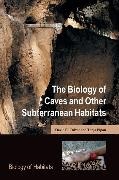Read more
Zusatztext The Biology of Caves and Other Subterranean Habitats is a scientific book that will be of considerable value to speleobiologists interested in cave biology. Informationen zum Autor David C. Culver received his Ph.D. in 1970 in Biology from Yale University. He is currently Professor of Biology and Associate Dean for Science at American University in Washington! DC! with broad research interests in subterranean biology! especially biodiversity! biogeography! and ecosystem function. Culver is Treasurer of the Karst Waters Institute! a member of the Virginia Cave Board! and an Honorary Life Member of the National Speleological Society.Tanja Pipan received her Ph.D. in 2003 in Biology from University of Ljubljana. She is currently Research Fellow at the Karst Research Institute ZRC-SAZU with research interests in the ecology! biology! and systematics of the subterranean copepod fauna! especially in the epikarst. Pipan is country coordinator for the Slovenian Long Term Ecological Research program! and Assistant Professor of Karstology at University of Koper. She received the 2004 award from the International Society forSubterranean Biology for best presentation at the meeting in Raipur! India and an award in 2005 for best paper at the International Association of Hydrogeology meeting in Kotar! Montenegro. Klappentext This book offers a concise but comprehensive introduction to cave ecology. The emphasis is on the organisms that dominate this unique environment! although conservation and management aspects are also considered. The book is intended for both graduate students and professionals and assumes no previous knowledge of cave biology. Zusammenfassung Caves and other subterranean habitats with their often strange (even bizarre) inhabitants have long been objects of fascination! curiosity! and debate. The question of how such organisms have evolved! and the relative roles of natural selection and genetic drift! has engaged subterranean biologists for decades. Indeed! these studies continue to inform the more general question of adaptation and evolution. However! interest in subterranean biology is not limited toquestions of evolutionary biology. Both the distribution and the apparent ancient age of many subterranean species continue to be of significant interest to biogeographers. Subterranean ecosystems generally exhibit little or no primary productivity and! as "extreme" ecosystems! provide general insightsinto ecosystem function. Furthermore! the simplicity of subterranean communities relative to most surface-dwelling communities makes them useful model systems for the study of species interactions such as competition and predation! as well as more general principles of ecosystem function. The rarity of many cave species makes them of special interest in conservation biology.The Biology of Caves and other Subterranean Habitats offers a concise but comprehensive introduction to cave ecology. Whilst there is an emphasis on the organisms that dominate this unique environment! conservation and management aspects are also considered. The book includes a global range of examples and case studies from both caves and non-cave subterranean habitats; it also provides a clear explanation of specialized terms used by speleologists. This accessible text will appeal toresearchers new to the field and to the many professional ecologists and conservation practitioners requiring a concise but authoritative overview. Its engaging style will also make it suitable for senior undergraduate and graduate students taking courses in cave and subterranean biology. ...

